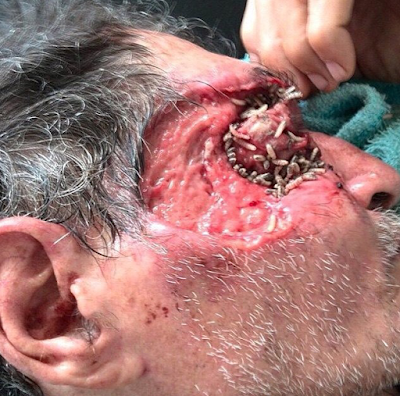Myiasis is an infestation of the skin by developing larvae (maggots) of a variety of fly species (myia is Greek for fly) within the arthropod order Diptera. In cutaneous myiasis, the 2 main clinical types are wound myiasis and furuncular (follicular) myiasis. Other forms include creeping/migratory myiasis and cavitary myiasis of body organs. In
nasopharyngeal myiasis, the nose, sinuses, and pharynx are involved.
Ophthalmomyiasis affects the eyes, orbits, and periorbital tissue, and
intestinal and urogenital myiasis involves invasion of the alimentary
tract or urogenital system.
Some flies attach their eggs to mosquitoes and wait for mosquitoes to bite people. Their larvae then enter these bites. Other flies' larvae burrow into skin. These fly larvae are known as
screwworms. They can enter skin through people's bare feet when they
walk through soil containing fly eggs or attach themselves to people's
clothes and then burrow into their skin. Another type of flies deposit their larvae on or near a wound or sore, depositing eggs in sloughing-off dead tissue.
Myiasis occurs in tropical and subtropical areas. These can include
countries in Central America, South America, Africa, and the Caribbean
Islands.Myiasis is not common in the United States. Most people in the
United States with myiasis got it when they traveled to tropical areas
in Africa and South America. People with untreated and open wounds are
more likely to get myiasis.
The larvae need to be surgically removed by a medical professional.
Typically, the wound is cleaned daily after the larvae are removed.
Proper hygiene of wounds is very important when treating myiasis.
Sometimes medication is given, depending on the type of larva that
causes the problem.

















No comments:
Post a Comment